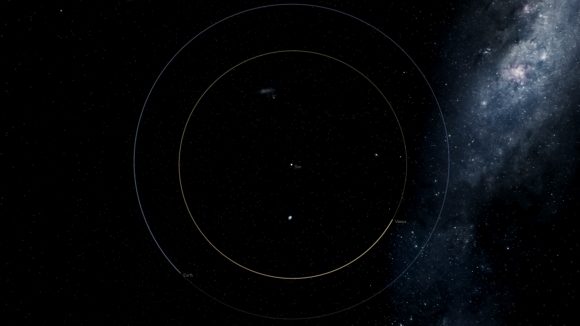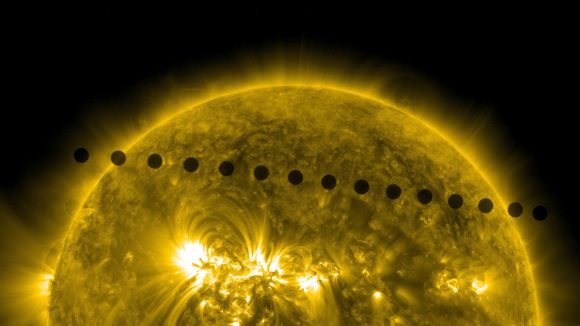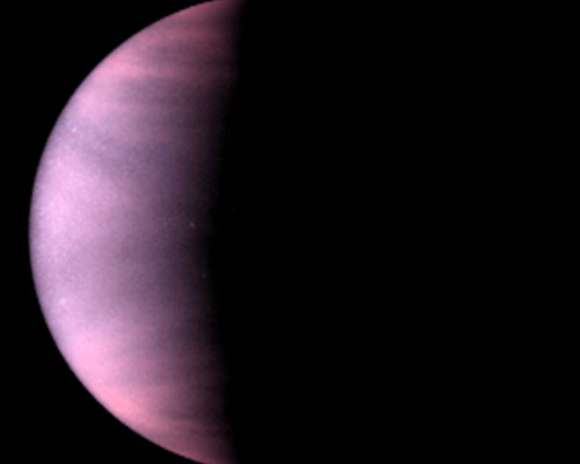Every few months a bright star appears in the sky. Sometimes it’s off to the East, bright in the morning before the Sun rises. Other times, you can see it in the West right after the Sun sets.
Experienced stargazers know this isn’t a star at all, of course, it’s Venus. That horrible twin planet, surrounded by a toxic choking atmosphere of superheated carbon dioxide. For a while it becomes the fourth brightest object in the sky: after the Sun, Moon and the International Space Station, if you can believe it.
In dark skies, Venus gets so bright you can even read a book to it.
Inexperienced stargazers, however, suddenly notice this super bright star in the sky. How come they never noticed it before? Was it always right next to the Moon like that? And that’s when the UFO calls to 911 start up.

I know none of them are going to be watching this video. But for everyone else, even mildly interested in the science here, let’s dig into the orbit of Venus, how we finally figured out what that thing is, how you can observe the planet, and some cool tricks Venus can do.
We’ve written several articles on what planet Venus actually is, and why it sucks so much. You know, a runaway greenhouse effect giving the planet 90 times the Earth’s atmospheric pressure at the surface. It’s a 462-degree furnace, anywhere you go, with a rain of sulfuric acid.

Nope, we’re not going to talk about visiting that place. Instead, we’re just going to talk about looking at it from afar, and how it changed our whole understanding about our place in the Solar System.
Venus is, of course, the second planet from the Sun. But for the vast majority of human history, nobody really understood what it was. It’s easy to see in the sky, even if you live in one of the most light polluted cities on Earth.
Ancient civilizations tried to grapple with what they were looking at, and of course, they assumed there was something supernatural going on. Probably dark and vengeful gods wandering through the heavens, staring down at us with their beady eyes. Judging, always judging. Some civilizations figured out that it’s a single object, while others believed they were looking at two separate entities.
The Ancient Greeks, for example, called the morning edition of Venus Phosphoros, the “Bringer of Light”, and they called the evening star Hesperos, the, uh, “Star of the Evening”. Then they realized it was a single object, and upgraded it to Aphrodite, the goddess of love. The Romans turned that into Venus, and the name stuck.

The ancient astronomers assumed the Earth was the center of the Universe, and all the planets and even the Sun and stars revolved around us. but Nicholas Copernicus worked out the true nature of the Solar System in the early 16th century. The Sun was at the center of the Solar System, and all planets, including Earth, orbited around it.
It was a cool story, and nicely fit the motions of the planets, however, the best evidence came almost a century later when Galileo turned his first crude telescope to Venus and realized that the planet goes through phases, just like the Moon. In fact, with a small telescope, you can confirm this all for yourself.
Each of the planets orbit the Sun. Mercury and Venus orbit closer to the Sun, then Earth, then the rest of the planets. When we observe Venus, we look inwards, down towards the Sun. When we see the rest of the planets, we’re looking outward, away from the Sun.
The best analogy is a car race. If you’re in the stands watching those cars go around and around, you’re turning your head back and forth as the cars pointlessly circle in front of you. But to see cars in the ring road around the racetrack, you’ll need to look all the way round you. Make sense?

Here’s a simplified version of the Solar System, with just the Earth, Venus, and the Sun. Earth, as you probably know, takes just over 365 days to go around the Sun, while Venus only takes 225 days to complete an orbit.
Which means that Venus completes more than 3 orbits every time Earth completes 2. Which means that we’re always seeing Venus from different angles compared to the Sun.
Sometimes it’s on the same side of the Sun as us. Other times it’s on the opposite. And sometimes Venus is on one side of the Sun, or the other. For about 9 and a half months, Venus is the evening star, brightening to its maximum, and then it spends another 9 and a half months as the morning star.
When all three are lined up, astronomers call that a conjunction. It’s a superior conjunction if Venus is on the opposite side of the Sun, and an inferior conjunction if it’s between us and the Sun.
When Venus is on either side, we measure its elongation, eastern or western. Because Venus orbits close to the Sun, the absolute maximum it can get is 47-degrees elongation. Make a triangle, where you point one line at the Sun, and another line at Venus, the angle of this triangle can’t get any bigger than 47-degrees.
And this is why we always see Venus relatively close to the Sun in the sky. There are 360 total degrees you can look, but Venus never leaves 90 of them.

Now, onto the phases. Just like the Moon, when Venus is in between us and the Sun, then all the light is falling on the far side of Venus. The side facing towards the Sun, but facing away from us. Of course, Venus is also hidden by the glare of the Sun, which means we really can’t even see it. The opposite happens when it’s on the other side of the Sun. It would be fully illuminated from our perspective. Too bad we can’t see it in all that glare.
But when Venus is on either side, this is when we can finally see it. As our perspective changes, we’re seeing more and more of the planet illuminated, and less in shadow. We see phases. We can see a crescent Venus, or a quarter Venus, or a gibbous Venus.
When Venus is almost fully illuminated, it’s actually at its dimmest because it’s so far away. Then as it moves higher and higher in the sky, we see less of it illuminated, but more overall surface area, so it gets brighter. The point of maximum brightness, when it’s blazing brighter than almost any other object in the sky is when the greatest amount of surface area of Venus is visible to us. Astronomers call this the greatest illuminated extent.
Venus is beautiful in the evening right now as I’m recording this video. We won’t see it this bright in the evening sky until August 2017, and then March, 2020. So, get out and enjoy it while you can.
When Venus passes directly in front of the Sun, that’s a planetary transit. The last time it happened was back in 2012, and before that, 2004. Unfortunately, the next transit of Venus won’t happen until 2117. I’m sure I’ll be still around, living it up in my robot body.
You’d might wonder why they don’t line up every time Venus passes between the Earth and the Sun. That’s because both Earth and Venus are slightly tilted in their orbits. Sometimes we see Venus above the Sun when it’s directly across from us, other times it’s below the Sun. It’s only after more than 100 years they directly line up again.

It turns out that transits of Venus gave us some of the most valuable discoveries in human history.
Today we know that the Sun is approximately 150 million kilometers away. But for the longest time we had no idea how far away the planets are. We know how far away everything is in proportion to everything else, but not in absolute terms.
In 1663, the Scottish mathematician James Gregory calculated that by making very precise measurements of the transits of Venus or Mercury, you could use trigonometry to figure out the actual distance from the Earth to the Sun. The famed astronomer Edumund Halley did even more detailed calculations and suggesedt places on the Earth to make measurements from.
It wasn’t until the 1700s that astronomers got organized enough to make worldwide measurements during a transit of Venus.
Astronomers tried to observe the Venus transit of 1761, but the weather conditions were pretty bad. In the 1769 transit, however, astronomers were sent to various corners of the globe. In Canada, Norway and the South Pacific. Nations fighting each other allowed astronomers safe passage through on ships through the warzone.
All of the observers made 4 observations: when Venus was touching the edge of the Sun, when it was fully inside, when it had touched the other side, and when it was fully out.
By combining all these measurements across the Earth, astronomers calculated that the distance from the Earth to the Sun was 93,726,900 English miles. The most accurate number we have today is 92,955,000 miles, or about 150 million kilometers. They were only off by about 1%. Not bad.
Once we knew the distance from the Earth to the Sun, we could calculate the distance to the other planets, even to other stars. All thanks to Venus.
Venus is one of the most dependable companions we have in the night sky. Sure, it’s a hellish death world, but from our perspective here on Earth, it’s really cool to look at. Don’t miss the next opportunity to see Venus with your own eyeballs. And if you can, get your hands on a telescope and see the planet going through its phases. You won’t regret it.
Did you get a chance to see the last transit of Venus, back in 2012? Give me the details of your experience in the comments.



